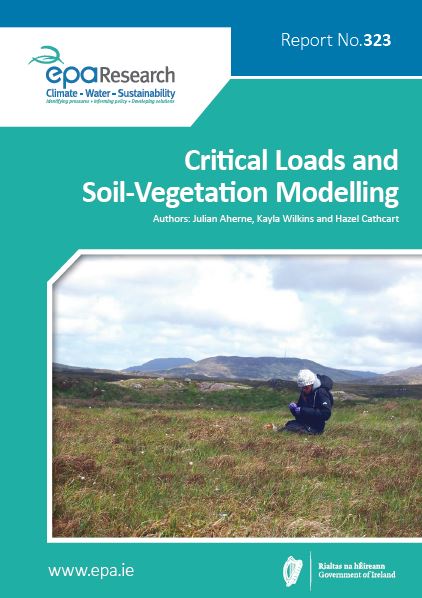Authors: Julian Aherne, Kayla Wilkins and Hazel Cathcart
Summary: This report presents results from the research project “Critical Loads and Soil-Vegetation Modelling”. The principal objectives of this project were to update critical loads of acidity and eutrophication for terrestrial and aquatic ecosystems in Ireland, to evaluate the potential impacts of nitrogen deposition on plant species diversity.

The Air Convention under the United Nations Economic Commission for Europe (UNECE) was the first international legally binding instrument to deal with the problems of air pollution on a broad regional scale. The Convention established six International Cooperative Programmes (ICPs) on Forests, Waters, Materials, Vegetation, Integrated Monitoring, and Modelling and Mapping to identify the most endangered areas, ecosystems and other receptors by considering the damage that has been caused to terrestrial and aquatic ecosystems and materials.
Air pollution can have unacceptable impacts on the natural environment. Pollutants, such as sulfur and nitrogen oxides, can travel several hundred or even thousands of kilometres before damage, for example acidification and eutrophication, occurs. Initial efforts to reduce the extent of environmental damage led to national and international legislation aimed at controlling emissions of long-range transboundary air pollution. The work of the Air Convention has underpinned scientific research on the impacts of air pollution during the last three decades. Emphasis on a cost-effective abatement strategy, based on scientific criteria, led to the development of the critical loads concept. In simple terms, this concept indicates how much pollutant deposition an ecosystem can tolerate without undergoing unacceptable long-term damage.
Critical loads are widely used as a tool for assessing the sensitivity of terrestrial and aquatic habitats; exceedance, whereby atmospheric pollutant deposition is greater than the habitat critical load, is used as an indicator of unacceptable effects. The critical loads approach underpins emissions reduction policies under UNECE’s Air Convention. In addition, critical loads are widely used by European Union Member States to assess the impacts of national policies on the level of exceedance, evaluate the permitting and licensing of emissions from industrial and agricultural facilities, and support Appropriate Assessments under Article 6.3 of the Habitats Directive (92/43/EEC).
This report describes the determination of critical loads of acidity and eutrophication for terrestrial and aquatic ecosystems in Ireland. In addition, the project evaluated the potential impacts of nitrogen deposition on plant species diversity and expanded national participation in the ICPs. The project specifically responded to “calls for data” under the Air Convention. The report describes the critical load database submitted to ICP Modelling and Mapping in response to the 2015–2017 call for data, the response to ICP Vegetation under the 2015 Moss Biomonitoring Survey, and the submission of water chemistry data to ICP Waters. National critical load data have made an important contribution to the abatement of long-range transboundary air pollution; however, critical loads have been virtually ignored under national policy assessments. It is recommended that national participation in the well-established network of ICPs should be formalised and strengthened. The long-standing network provides an obvious framework for national monitoring activities, such as the requirement for ecosystem monitoring under the EU National Emission Ceilings Directive (2016/2284/EU).
https://www.epa.ie/media/epa-2020/publications/research/Research-323-thumbnail.JPG